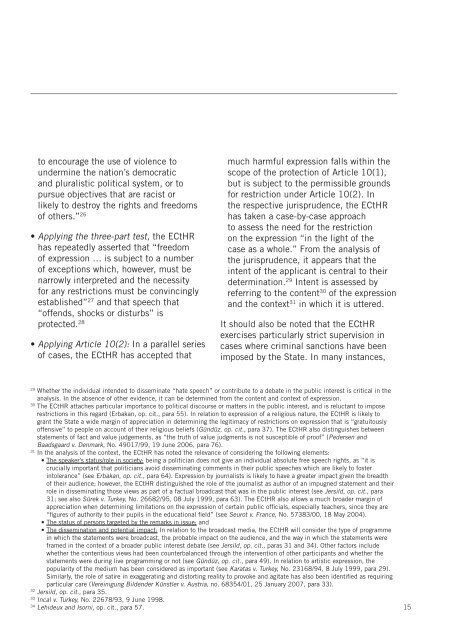ARTICLE-19-policy-on-prohibition-to-incitement
ARTICLE-19-policy-on-prohibition-to-incitement
ARTICLE-19-policy-on-prohibition-to-incitement
Create successful ePaper yourself
Turn your PDF publications into a flip-book with our unique Google optimized e-Paper software.
<strong>to</strong> encourage the use of violence <strong>to</strong><br />
undermine the nati<strong>on</strong>’s democratic<br />
and pluralistic political system, or <strong>to</strong><br />
pursue objectives that are racist or<br />
likely <strong>to</strong> destroy the rights and freedoms<br />
of others.” 26<br />
• Applying the three-part test, the ECtHR<br />
has repeatedly asserted that “freedom<br />
of expressi<strong>on</strong> … is subject <strong>to</strong> a number<br />
of excepti<strong>on</strong>s which, however, must be<br />
narrowly interpreted and the necessity<br />
for any restricti<strong>on</strong>s must be c<strong>on</strong>vincingly<br />
established” 27 and that speech that<br />
“offends, shocks or disturbs” is<br />
protected. 28<br />
• Applying Article 10(2): In a parallel series<br />
of cases, the ECtHR has accepted that<br />
much harmful expressi<strong>on</strong> falls within the<br />
scope of the protecti<strong>on</strong> of Article 10(1),<br />
but is subject <strong>to</strong> the permissible grounds<br />
for restricti<strong>on</strong> under Article 10(2). In<br />
the respective jurisprudence, the ECtHR<br />
has taken a case-by-case approach<br />
<strong>to</strong> assess the need for the restricti<strong>on</strong><br />
<strong>on</strong> the expressi<strong>on</strong> “in the light of the<br />
case as a whole.” From the analysis of<br />
the jurisprudence, it appears that the<br />
intent of the applicant is central <strong>to</strong> their<br />
determinati<strong>on</strong>. 29 Intent is assessed by<br />
referring <strong>to</strong> the c<strong>on</strong>tent 30 of the expressi<strong>on</strong><br />
and the c<strong>on</strong>text 31 in which it is uttered.<br />
It should also be noted that the ECtHR<br />
exercises particularly strict supervisi<strong>on</strong> in<br />
cases where criminal sancti<strong>on</strong>s have been<br />
imposed by the State. In many instances,<br />
29<br />
Whether the individual intended <strong>to</strong> disseminate “hate speech” or c<strong>on</strong>tribute <strong>to</strong> a debate in the public interest is critical in the<br />
analysis. In the absence of other evidence, it can be determined from the c<strong>on</strong>tent and c<strong>on</strong>text of expressi<strong>on</strong>.<br />
30<br />
The ECtHR attaches particular importance <strong>to</strong> political discourse or matters in the public interest, and is reluctant <strong>to</strong> impose<br />
restricti<strong>on</strong>s in this regard (Erbakan, op. cit., para 55). In relati<strong>on</strong> <strong>to</strong> expressi<strong>on</strong> of a religious nature, the ECtHR is likely <strong>to</strong><br />
grant the State a wide margin of appreciati<strong>on</strong> in determining the legitimacy of restricti<strong>on</strong>s <strong>on</strong> expressi<strong>on</strong> that is “gratui<strong>to</strong>usly<br />
offensive” <strong>to</strong> people <strong>on</strong> account of their religious beliefs (Gündüz, op. cit., para 37). The ECtHR also distinguishes between<br />
statements of fact and value judgements, as “the truth of value judgments is not susceptible of proof” (Pedersen and<br />
Baadsgaard v. Denmark, No. 49017/99, <str<strong>on</strong>g>19</str<strong>on</strong>g> June 2006, para 76).<br />
31<br />
In the analysis of the c<strong>on</strong>text, the ECtHR has noted the relevance of c<strong>on</strong>sidering the following elements:<br />
• The speaker’s status/role in society: being a politician does not give an individual absolute free speech rights, as “it is<br />
crucially important that politicians avoid disseminating comments in their public speeches which are likely <strong>to</strong> foster<br />
in<strong>to</strong>lerance” (see Erbakan, op. cit., para 64). Expressi<strong>on</strong> by journalists is likely <strong>to</strong> have a greater impact given the breadth<br />
of their audience; however, the ECtHR distinguished the role of the journalist as author of an impugned statement and their<br />
role in disseminating those views as part of a factual broadcast that was in the public interest (see Jersild, op. cit., para<br />
31; see also Sürek v. Turkey, No. 26682/95, 08 July <str<strong>on</strong>g>19</str<strong>on</strong>g>99, para 63). The ECtHR also allows a much broader margin of<br />
appreciati<strong>on</strong> when determining limitati<strong>on</strong>s <strong>on</strong> the expressi<strong>on</strong> of certain public officials, especially teachers, since they are<br />
“figures of authority <strong>to</strong> their pupils in the educati<strong>on</strong>al field” (see Seurot v. France, No. 57383/00, 18 May 2004).<br />
• The status of pers<strong>on</strong>s targeted by the remarks in issue; and<br />
• The disseminati<strong>on</strong> and potential impact: In relati<strong>on</strong> <strong>to</strong> the broadcast media, the ECtHR will c<strong>on</strong>sider the type of programme<br />
in which the statements were broadcast, the probable impact <strong>on</strong> the audience, and the way in which the statements were<br />
framed in the c<strong>on</strong>text of a broader public interest debate (see Jersild, op. cit., paras 31 and 34). Other fac<strong>to</strong>rs include<br />
whether the c<strong>on</strong>tentious views had been counterbalanced through the interventi<strong>on</strong> of other participants and whether the<br />
statements were during live programming or not (see Gündüz, op. cit., para 49). In relati<strong>on</strong> <strong>to</strong> artistic expressi<strong>on</strong>, the<br />
popularity of the medium has been c<strong>on</strong>sidered as important (see Karatas v. Turkey, No. 23168/94, 8 July <str<strong>on</strong>g>19</str<strong>on</strong>g>99, para 29).<br />
Similarly, the role of satire in exaggerating and dis<strong>to</strong>rting reality <strong>to</strong> provoke and agitate has also been identified as requiring<br />
particular care (Vereinigung Bildender Künstler v. Austria, no. 68354/01, 25 January 2007, para 33).<br />
32<br />
Jersild, op. cit., para 35.<br />
33<br />
Incal v. Turkey, No. 22678/93, 9 June <str<strong>on</strong>g>19</str<strong>on</strong>g>98.<br />
34<br />
Lehideux and Isorni, op. cit., para 57.<br />
15


